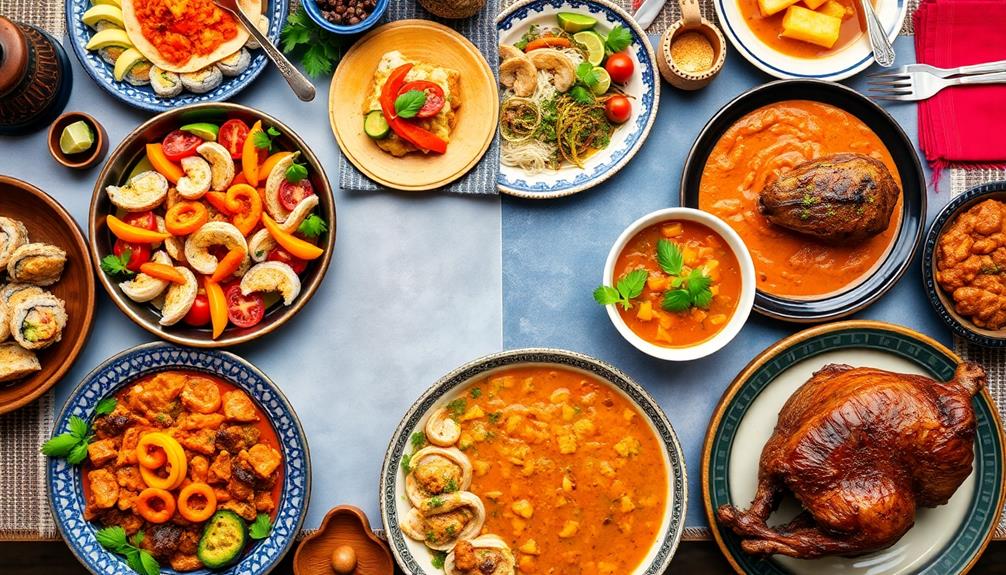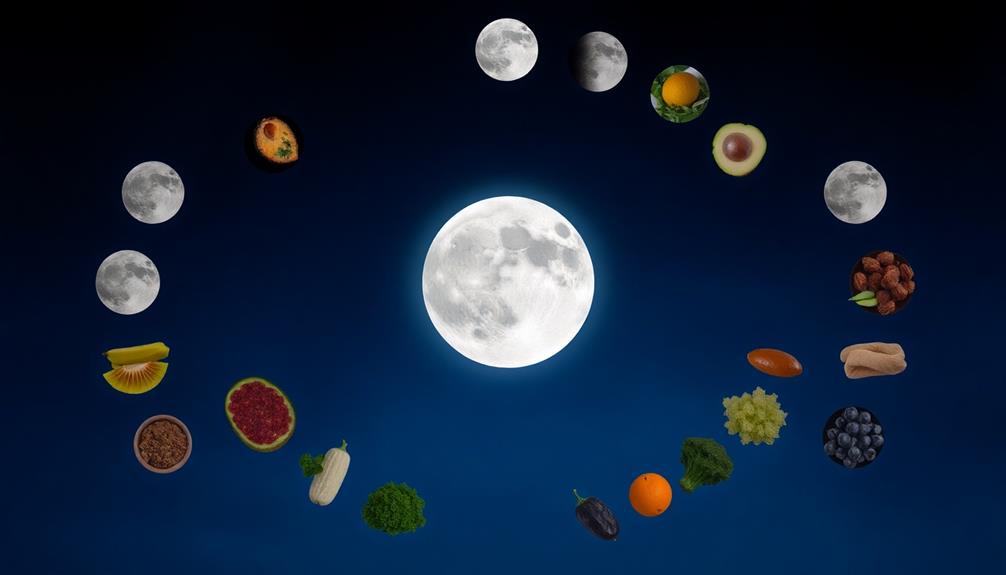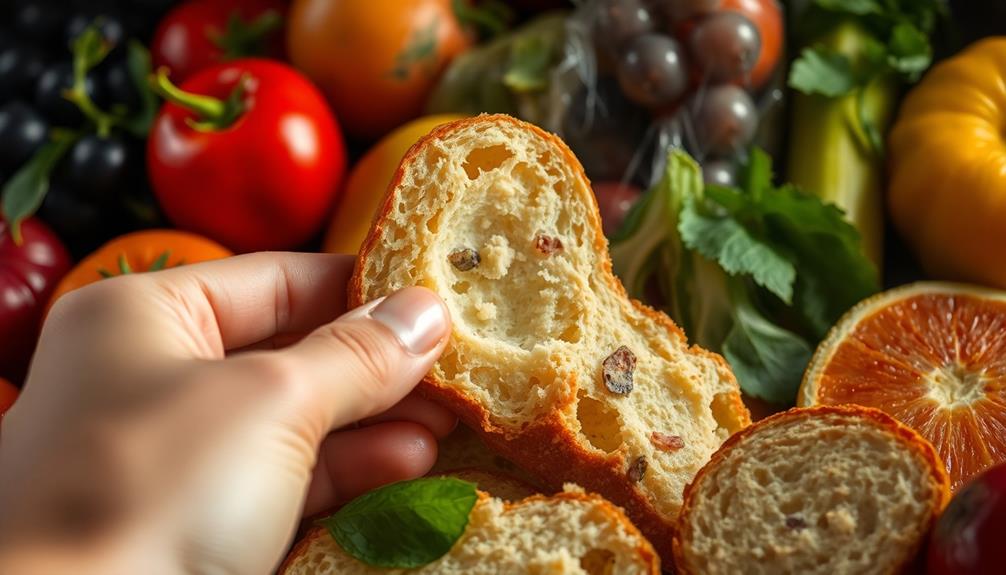Cultural taboos play a significant role in shaping global cuisine by dictating what you can and can't eat based on societal beliefs and values. These restrictions stem from religion, tradition, and communal identity, affecting dietary choices across regions. For instance, pork is avoided in Islam and Judaism, while Hinduism reveres cows, leading to vegetarianism in India. Such taboos not only influence daily meals but also enhance culinary diversity, as cultures adapt to local ingredients while respecting dietary laws. If you explore further, you'll discover how these evolving taboos continue to impact modern culinary trends and global food practices.
Key Takeaways
- Cultural taboos dictate acceptable food consumption, influencing dietary practices across different societies and communities worldwide.
- Religious dietary laws, such as kosher and halal, shape culinary traditions and reinforce spiritual and communal identities.
- Sacred animal restrictions, like the reverence for cows in Hinduism, significantly impact regional cuisines and food choices.
- Historical and ecological reasons for food taboos foster resource management and enhance culinary diversity within cultures.
- Dietary practices tied to spirituality, such as vegetarianism in Buddhism, reflect personal beliefs and shape global culinary landscapes.
Defining Cultural Taboos
Cultural taboos are social or religious restrictions surrounding the consumption of specific foods, deeply rooted in a society's beliefs about purity, health, and morality. These food taboos create dietary restrictions that vary widely from culture to culture. For instance, while pork is forbidden in Judaism and Islam, it's a staple in many Western diets. This stark contrast highlights how cultural values shape what's acceptable to eat.
In Mexican cuisine, traditional dishes like Chilaquiles showcase the creative use of leftover ingredients, reflecting how cultural practices influence culinary innovation.
In many societies, food taboos also relate to significant life stages or events. Pregnant women, for example, often avoid certain foods to protect fetal health, like eggs in Indonesia. This practice underscores how cultural beliefs intersect with maternal care, influencing dietary choices during pregnancy.
Scholars like Marvin Harris argue that food taboos can serve ecological or survival purposes, helping societies manage resources and mitigate health risks associated with specific foods. Additionally, these taboos help foster group cohesion and identity.
For example, the avoidance of dogs and cats as food in American culture stems from historical associations with pets and moral views on animal rights. Understanding these taboos enriches your perspective on global cuisine and the diverse beliefs that shape it.
Historical Context of Taboos
Throughout history, food taboos have played a significant role in shaping societies and their culinary practices. You can see this in ancient civilizations like Egypt, where food was central to rituals and offerings. These practices highlight how deeply ingrained dietary restrictions were in their culture.
The concept of "Elysian Land" also reflects humanity's long-standing recognition of food's spiritual and social importance. In Brazil, for instance, many traditional dishes, such as Caldeirada and Caruru, showcase how cultural influences and taboos intersect in the culinary landscape. Historical records reveal how taboos, such as the dietary laws of ancient Hebrews, have influenced modern culinary practices. This shows that prohibitions on certain foods often have roots in ecological and cultural reasons.
Scholars like Marvin Harris argue that food taboos serve to protect communities and enhance social cohesion. They foster shared beliefs that bind people together.
As time passed, some food taboos evolved from practical restrictions into aspects of cultural identity. Take the avoidance of pork in Judaism and Islam, for instance; these taboos persist today, shaping the eating habits of millions. By understanding this historical context, you can appreciate how food taboos continue to influence culinary traditions across the globe.
Regional Variations in Cuisine
Regional variations in cuisine often reflect the unique food taboos that shape local culinary practices. These taboos can dictate what ingredients are used and how meals are prepared, leading to diverse culinary landscapes around the world. Here are some notable examples:
- Middle East: The prohibition of pork in Islamic and Jewish cultures leads to a preference for lamb and chicken in many dishes, showcasing alternative proteins. This can be seen in dishes like Mushroom Masala, which highlights vegetarian options that are popular in the region.
- Ethiopia: The cultural practice of eating with hands and sharing communal plates emphasizes togetherness, with injera acting as a versatile staple for various dishes.
- Italy: Strict food taboos, like avoiding cheese with seafood, shape regional variations, resulting in unique culinary creations that respect these traditions.
- India: The sacred status of cows contributes to a largely vegetarian diet, with many regions crafting meals rich in lentils, vegetables, and dairy, reflecting deep-rooted cultural beliefs.
Dishes like Gobi Manchurian further exemplify how local ingredients are creatively utilized to cater to these dietary restrictions.
These examples illustrate how cultural practices and food taboos not only influence local diets but also define the culinary identity of regions across the globe. Understanding these variations can enhance your appreciation for the rich tapestry of global cuisine.
Religious Influences on Food
When you explore religious influences on food, you'll find that many faiths impose specific dietary laws that shape what's acceptable to eat.
For instance, Judaism and Islam both prohibit pork, while Hinduism holds cows as sacred, leading to beef avoidance.
These sacred animal restrictions and dietary practices not only reflect spiritual beliefs but also greatly impact communal eating habits and food culture worldwide.
Additionally, cultural dishes like Kawarma (Preserved Meat) demonstrate how preservation methods are often influenced by regional religious customs and practices.
Sacred Animal Restrictions
Sacred animal restrictions often play a crucial role in shaping dietary practices across various cultures. These food taboos stem from deep-rooted beliefs and contribute to community identity.
For example, in Chinese cuisine, certain dishes like Red-Braised Pork Belly highlight the cultural significance of specific ingredients, while the avoidance of certain meats may reflect similar sacred beliefs. You might be surprised at how these dietary restrictions manifest around the globe:
- Hinduism in India: Cows are revered as sacred symbols, leading to strict prohibitions against beef consumption. They represent abundance and maternal nourishment, making them untouchable in many households.
- Judaism: Jewish kosher laws dictate permissible animal consumption, including avoiding the mixing of meat and dairy. This meticulous adherence reflects profound spiritual significance.
- Islam: The consumption of pork is forbidden in Islam. Halal dietary laws guide Muslims in choosing food that emphasizes cleanliness and spiritual purity.
- Native American Cultures: Certain sacred animals, like the eagle, hold spiritual significance, leading to respectful abstention from consumption, reinforcing a connection to nature.
These sacred animal restrictions not only dictate what you can or can't eat but also strengthen community bonds. By adhering to these dietary restrictions, cultures maintain their identity and values, showcasing the powerful influence of religion on cuisine.
Dietary Laws and Practices
Dietary laws and practices frequently shape what people eat and how they approach food across various cultures. In Judaism, Kashrut dictates dietary preferences by prohibiting pork and shellfish while requiring the separation of meat and dairy. This creates specific food taboos that profoundly influence Jewish culinary traditions.
Similarly, Islamic halal laws outline permissible foods, forbidding pork and alcohol, and mandating humane slaughter methods, reinforcing spiritual significance in daily meals. In regions like East Africa, dishes like Mandazi reflect local culinary practices that may intertwine with spiritual beliefs, showcasing how food can serve as both nourishment and cultural expression.
Hindu dietary practices often lean towards vegetarianism, with many avoiding beef due to the cow's sacred status, reflecting deep cultural reverence. The Seventh-day Adventist Church encourages a vegetarian diet, intertwining health and spirituality while adhering to biblical definitions of clean and unclean foods.
In Buddhist communities, dietary restrictions may include vegetarianism and avoiding garlic and onions, promoting non-violence and spiritual purity.
These dietary laws and practices create a rich tapestry of global cuisine, highlighting how deeply personal and communal beliefs influence what's on your plate. Understanding these factors can enhance your appreciation for the diverse culinary landscape shaped by cultural taboos and spiritual significance.
Culinary Risks and Rewards
Culinary risks often create a tantalizing allure that draws adventurous eaters to explore unique flavors and experiences.
These risks can push the boundaries of your palate, revealing how food taboos and cultural beliefs shape what's considered acceptable to eat. For instance, traditional Japanese delicacies like Dorayaki showcase how cultural heritage influences the enjoyment of sweet treats.
Here are four examples of culinary risks that showcase this intricate relationship:
- Fugu (pufferfish): This delicacy requires skilled chefs trained to prepare it safely, balancing the thrill of danger with exquisite taste.
- Insect consumption: While embraced in countries like Thailand as a sustainable protein source, Western societies often shy away due to cultural aversions.
- Fermented shark (Hákarl): In Iceland, this traditional dish undergoes a lengthy fermentation process to neutralize its toxicity, turning a risky ingredient into a cherished delicacy.
- Escargot in France: Considered gourmet, snails face disdain in other regions, highlighting how cultural perceptions can elevate or diminish a food's status.
Embracing culinary risks can lead to unforgettable experiences, but understanding the underlying cultural beliefs helps you navigate the complex landscape of global cuisine.
Symbolism in Food Choices
Have you ever considered how deeply food choices are intertwined with cultural symbolism? In many cultures, what you eat isn't just about taste; it's also about meaning. For instance, in Chinese culture, serving fish upside-down is a sign of bad luck, while fish itself symbolizes abundance and prosperity. This shows how presentation can carry considerable symbolism.
Similarly, in Thai culture, dishes such as Khanom Tan and Sai Oua reflect the rich flavors and traditional practices that are deeply rooted in their heritage.
In India, cows are revered as sacred symbols of abundance and purity, leading to widespread taboos against beef consumption, which shapes dietary practices considerably. Meanwhile, in Japan, the culinary risk of consuming fugu reflects a thrilling blend of danger and flavor, highlighting the artistry and tradition behind their cuisine.
In Ethiopia, sharing food from a communal plate with injera emphasizes connection and community, showcasing the importance of togetherness in dining experiences. Conversely, the acceptance of insects in Thai cuisine illustrates resourcefulness and sustainability, contrasting sharply with Western aversions.
These examples demonstrate that food choices are laden with symbolism, influenced by cultural taboos, and shape dietary norms around the globe. Understanding this aspect can deepen your appreciation for the diverse culinary landscape.
Taboos and Health Perceptions
Food choices shaped by cultural symbolism often intersect with health perceptions, revealing how taboos can greatly influence nutritional habits. In many cultures, these taboos can lead to nutrient deficiencies, particularly in developing countries. For instance, restrictions on specific foods during pregnancy can compromise maternal and child health.
In Vietnam, traditional dishes like Cylindrical Sticky Rice Cake may be avoided during certain times due to beliefs surrounding their ingredients or preparation methods, impacting dietary variety and nutritional intake.
Here are some key ways food taboos can help shape health perceptions:
- Cultural Beliefs: In some societies, avoiding pork is rooted in beliefs about purity and health risks, impacting overall dietary patterns.
- Nutritional Barriers: Taboos against iron-rich foods, like blood-based products, can prevent individuals from obtaining essential nutrients.
- Sustainable Choices: In contrast, the consumption of insects is seen as a nutritious protein source in many cultures, despite being taboo in Western societies.
- Maternal Nutrition: Restrictions around foods like eggs during pregnancy in Indonesia illustrate how cultural beliefs can affect dietary choices and fetal development.
Understanding these food taboos is significant, as they can help reveal how deeply intertwined cultural practices are with health perceptions, influencing what people eat and the nutritional quality of their diets.
The Role of Tradition
Tradition considerably influences what you eat, shaping the food taboos that define various cultures around the world. These taboos often stem from deep-rooted cultural beliefs that dictate what's acceptable or forbidden on your plate.
| Culture | Food Taboos | Cultural Beliefs |
|---|---|---|
| India | Beef | Cows are revered, symbolizing purity and abundance. |
| Ethiopia | Individual plates | Communal eating fosters hospitality and community. |
| Judaism & Islam | Pork | Ancient dietary laws prohibit pork for religious reasons. |
| Japan | Fugu | Eating this delicacy requires trained chefs due to its danger. |
| isiXhosa (Africa) | Certain foods during pregnancy | Avoidance to protect newborn health based on tradition. |
These examples showcase how tradition informs dietary choices, often rooted in historical practices and religious beliefs. In India, the reverence for cows leads to the prohibition of beef, while in Ethiopia, sharing food symbolizes togetherness. Similarly, the meticulous preparation of fugu highlights the blend of artistry and risk in Japanese cuisine. Understanding these traditions offers insight into the food taboos you encounter around the globe.
Evolving Taboos in Modern Cuisine
As you explore modern cuisine, you'll notice how dietary restrictions are shifting, influenced by the rise of fusion foods and cross-cultural culinary exchanges.
Traditional dishes like satisfying comfort dishes are being reimagined, incorporating ingredients that once seemed taboo.
What once seemed taboo now finds a place on your plate, reflecting a broader acceptance of diverse ingredients and practices.
This evolution not only challenges your perceptions but also opens up exciting new flavors and experiences.
Changing Dietary Restrictions
In a world where culinary boundaries blur and evolve, dietary restrictions are undergoing significant transformation.
You'll notice that traditional taboos are being reinterpreted as globalization, health trends, and cultural exchanges redefine what's acceptable to eat.
Here are four key shifts in modern cuisine:
- Insect Consumption: Once a taboo, eating insects is gaining acceptance, particularly in Western diets, due to increased awareness of sustainability and protein alternatives.
- Plant-Based Diets: The rise of vegetarianism and veganism challenges old norms around animal products, prompting many to reconsider their dietary choices from moral and health perspectives.
- Cultural Fusion: Urban areas are thriving with culinary experiments that blend ingredients and traditions, often breaking down previous taboos surrounding food combinations.
- Social Media Influence: As individuals share their experiences with unconventional foods, social media accelerates the acceptance of new dietary practices, reshaping perceptions of what's considered taboo.
These changing dietary restrictions reflect a dynamic interplay of cultural fusion, encouraging you to expand your culinary horizons and challenge traditional notions of food and taboo foods.
Fusion Food Trends
The exploration of fusion food trends reveals how culinary innovation can reshape perceptions of what's acceptable to eat. Fusion cuisine boldly combines ingredients and techniques from diverse cultures, challenging traditional food taboos. You might find sushi burritos or Korean tacos on trendy menus, showcasing how culinary creativity thrives in a globalized world.
The rise of global travel and digital communication has also led to a greater acceptance of previously taboo foods. Unique combinations like bacon-wrapped dates and kimchi quesadillas have gained popularity, thanks in part to social media platforms. On Instagram, visually appealing fusion dishes often go viral, influencing culinary trends and encouraging you to try something new.
As culinary boundaries blur, food festivals and pop-up restaurants celebrate fusion dishes, reflecting a growing openness to diverse flavors.
Plus, the evolving nature of dietary restrictions, like plant-based diets, inspires chefs to adapt traditional recipes while respecting cultural roots. This dynamic landscape of fusion cuisine demonstrates that food taboos aren't static; they evolve with society, inviting you to expand your palate and embrace the delicious possibilities of global cuisines.
Cross-Cultural Culinary Exchanges
Food lovers everywhere are discovering how cross-cultural culinary exchanges can shift longstanding taboos. As global cuisine evolves, food taboos are challenged, leading to increased acceptance of unconventional ingredients and practices.
Here are four key ways these exchanges are reshaping our culinary landscape:
- Insect Consumption: Once considered unthinkable in Western diets, insects are gaining acceptance due to their nutritional benefits and sustainability, thanks to educational initiatives.
- Fusion Dishes: The blending of culinary traditions, like sushi burritos that merge Japanese and Mexican elements, showcases how cross-cultural culinary exchanges create innovative and exciting food experiences.
- Social Media Influence: Platforms allow food enthusiasts to share their culinary adventures, promoting acceptance of items like gourmet organ meats, which were previously stigmatized.
- Ethical Eating Movements: The rise of plant-based diets reflects changing attitudes towards traditional food taboos, emphasizing sustainability and ethical consumption.
These dynamics illustrate how cross-cultural culinary exchanges not only enrich our plates but also encourage a more inclusive understanding of global cuisine.
Cultural Exchange and Culinary Fusion
Through cultural exchange, culinary traditions have blended in exciting and unexpected ways, creating innovative dishes that reflect a rich tapestry of global influences. You might've noticed sushi burritos, which beautifully combine Japanese and Mexican flavors. This fusion showcases how food taboos can be challenged, allowing different cultures to coalesce on your plate.
The globalization of ingredients has also transformed local staples into worldwide phenomena. Take quinoa, for example; this South American grain now finds a place in various cuisines, highlighting how cultural exchange reshapes our culinary landscape.
In the United States, immigrant communities introduce their rich culinary traditions, making dishes like Indian curry, Chinese stir-fry, and Italian pasta mainstream favorites.
Moreover, culinary fusion often sparks unique dining experiences, such as Korean tacos that blend Korean barbecue with traditional Mexican tortillas. These innovations encourage chefs to experiment, pushing the boundaries of traditional cuisine.
The rise of fusion restaurants celebrates diverse cultural heritages while promoting a spirit of culinary experimentation, inviting you to explore the delicious results of cultural exchange. Embracing these flavors not only enriches your palate but also fosters a greater understanding of global cultures.
Frequently Asked Questions
What Are the Effects of Food Taboos?
Food taboos can limit your dietary choices, leading to potential nutritional deficiencies. They often create economic waste, restrict culinary diversity, and foster group identity, shaping how you and your community engage with food.
How Does Culture Affect Cuisine?
When it comes to culture affecting cuisine, you can't judge a book by its cover. Your food choices reflect your values, traditions, and beliefs, shaping what you eat and how you share meals with others.
How Do Taboos Affect Culture?
Taboos deeply influence your culture by establishing boundaries around acceptable behaviors and practices. They guide your values, shape your social interactions, and foster a sense of identity, helping you connect with others who share similar beliefs.
What Are Cultural Food Taboos?
Cultural food taboos are restrictions on certain foods based on beliefs, traditions, or health concerns. They reflect a community's values, guiding your dietary choices and influencing what you eat throughout your life.
Conclusion
In the grand tapestry of global cuisine, cultural taboos weave intricate patterns that shape what we eat and how we savor it. Just as a river carves its path through the landscape, these taboos flow through our plates, influencing flavors and traditions. As the world grows smaller and cultures intertwine, you'll find that breaking bread can break barriers, too. Embracing these culinary complexities can lead to new tastes and experiences, enriching our palates and our understanding of one another.









